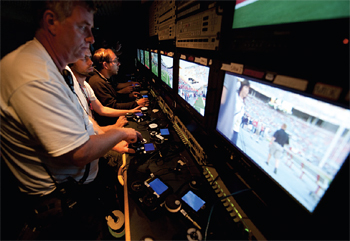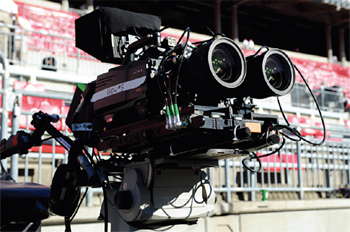ESPN Preps for 3DTV

BRISTOL, CONN.
ESPN will launch its new 3D channel on June 11 with the broadcast of the 2010 FIFA World Cup match between South Africa and Mexico. From then on, ESPN 3D will cover at least 84 more live sports events in the next 12 months; all in 3D. The network has signed up for up to 24 more 2010 FIFA World Cup matches, NBA, X Games 16, college basketball, and college football, including the BCS National Championship game in Glendale, Ariz. in January 2011.
Late last month, DirecTV said it would begin carrying ESPN 3D at its launch, in addition to two other 3D dedicated channels, a Panasonic channel called N3D, which will carry 3D programming from CBS, Fox Sports, NBC and others; as well as a dedicated 24/7 3D pay-per-view/VOD channel.
BAREBONES STARTUP
ESPN is no stranger to 3DTV production. Using NEP's Supershooter 3D production trailer—equipped with a Fusion 3D production system that supports up to eight pairs of HD cameras—the network has spent the last two years testing this technology. It shot the fall 2009 USC vs. OSU college football game in 3D, which was shown in some movie theaters, and USC's Galen Center, (see "NEP Pioneers 3DTV Production," Oct. 21, 2009). And in February, the sports network shot a Harlem Globetrotters game in 3D at the network's Innovation Lab in Orlando.
(Note: Current 3D technology uses a pair of HD cameras at each camera position, with one camera serving as the "left eye" and the other the "right eye." The two feeds are converged inside the production truck by stereographers who control the depth of field of the 3D image by adjusting the offset between the overlaid left-right video images.)

This 3D camera was used at last fall’s USC at Ohio State college football telecast. "ESPN 3D's programming will be based on live field shoots in 720p using a leased 3D production truck such as Supershooter 3D," Chuck Pagano, ESPN's executive vice president said. "We will not be building any new 3D studio facilities or investing on any other facilities yet; at least at the outset. This will allow us to freely test different approaches to producing 3DTV without getting caught up on costs. That's the same approach we used when we began working in HD, and it served us very well."
In the same vein, ESPN 3D will be an event-based network, which means that it will be activated when there is content to be shown, and then go dark the rest of the time. It will be up to TV distributors—cable, satellite, and telephone companies—to decide how the signals will be delivered to consumers. "We can do either side-by-side or top-bottom," Pagano says. "It depends on what the distributors want."
IS ANYONE WATCHING?
ESPN 3D is facing a rather significant problem: There are very few 3DTV sets available and those that do exist are expensive, just like the original HDTV sets a few years ago.
Pagano isn't fazed. "Manufacturers are getting on board with 3DTV, with about 100 different models being shown at CES this year," he said. "But what really matters is that consumers are interested in 3DTV; based on the research that we've done. Moreover, the cost difference between an HDTV set and 3DTV set is far less than it was between an HDTV set and an NTSC set a few years ago. And 3DTV sets can support 2D HDTV, while analog TVs could not handle HD. So, at minimum, someone buying a HDTV set can use it today for HD, knowing that they will be able to watch 3D whenever it is available."
At press time, ESPN 3D only had access to one 3DTV production truck; namely NEP's Supershooter 3D. Until more trucks become available for lease, ESPN 3D's coverage will be limited to Supershooter 3D's availability and up-time. That's a lot of responsibility to put upon a single mobile unit.
As well, the network is still struggling to master the art of 3D storytelling, just as it did with HD in the past. "3D requires its own language," says Pagano. "We have to decide what degree of depth of field is right, and at what distance. For instance, 3D adjusted to mimic standard human vision doesn't make the ball pop out in a wide shot; should we increase the depth of field to heighten the experience? And how do we do this without making our programming pop so much that it's like a bad horror movie? These are decisions that have to be made, and we will only learn how to make them through practice."

This 3D camera was used at last fall’s USC at Ohio State college football telecast. That said, ESPN is planning its own 3D broadcast facilities, and working to advance 3DTV's state-of-the-art at its Innovation Lab. To this end, the network recently purchased Vistas Unlimited; a Texas-based software developer of "virtual insertions," (i.e., corporate logos superimposed on playing fields during live TV events). "Vistas will be helping us develop new storytelling tools for 3D," Pagano said.
Is ESPN making a smart move by staking out 3DTV today? It's too early to tell, replies Dan Rayburn, principal analyst with Frost & Sullivan.
"Is there a market for 3DTV content? Right now, no." Rayburn said. "But does it make sense for an organization like ESPN to lay the groundwork for 3DTV? Given that they apparently can afford to do it, the answer is yes. I have no idea when or even if there will be mass-market demand for 3DTV content, but ESPN will be ready to feed this demand should it arise."
LOOKING AHEAD
These are heady days at ESPN 3D, as they tackle the next frontier in TV production. But Pagano is already looking past 3DTV, wondering what could be the "next big thing."
"There's been a lot of talk about 3D direct view, as opposed to having to wear glasses when you watch them," he said. "In fact, NHK is about to launch direct view programming. But I want to see things go further than this; say holographic TV, for instance. As a Star Trek fan, I would love to have my own personal holodeck, and I'm sure I'm not alone."
Given how fast 3DTV is progressing, Pagano may one day realize his "holo-dreams." In the interim, ESPN 3D should be a solid first step towards this sci-fi goal.
Get the TV Tech Newsletter
The professional video industry's #1 source for news, trends and product and tech information. Sign up below.
James Careless is an award-winning journalist who has written for TV Technology since the 1990s. He has covered HDTV from the days of the six competing HDTV formats that led to the 1993 Grand Alliance, and onwards through ATSC 3.0 and OTT. He also writes for Radio World, along with other publications in aerospace, defense, public safety, streaming media, plus the amusement park industry for something different.

